NASA's Artemis 1 mission on track for launch despite lightning hits
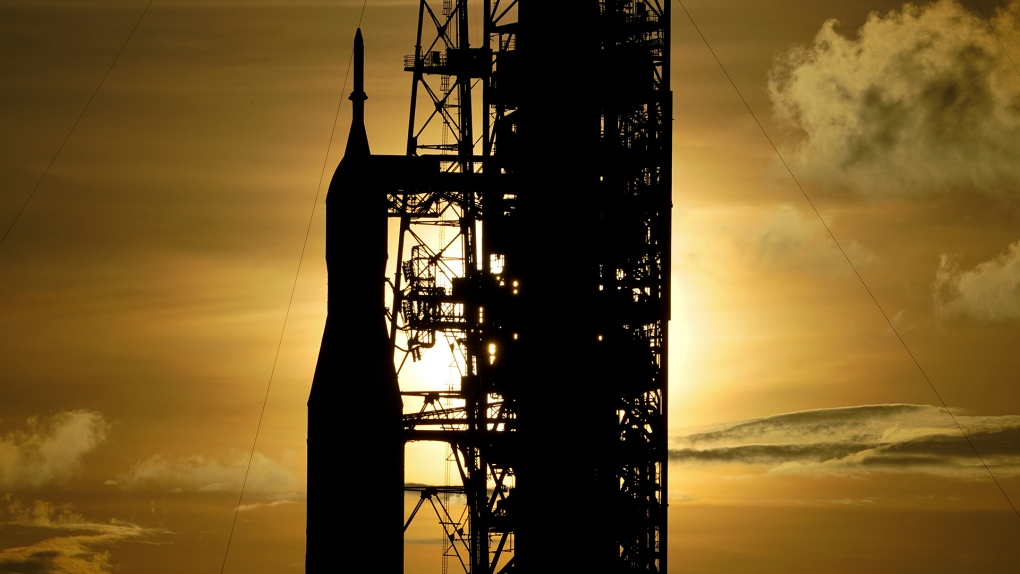
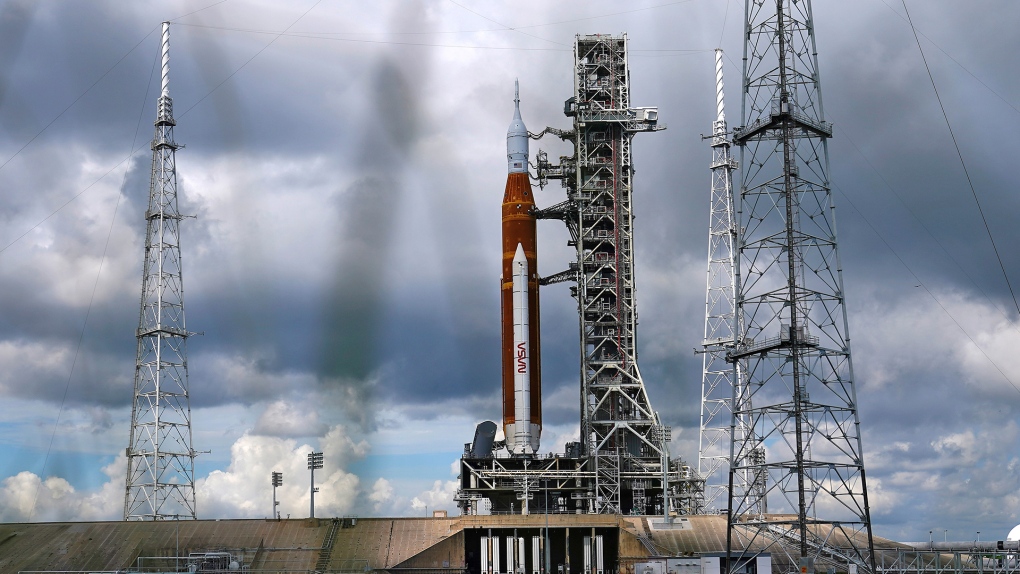
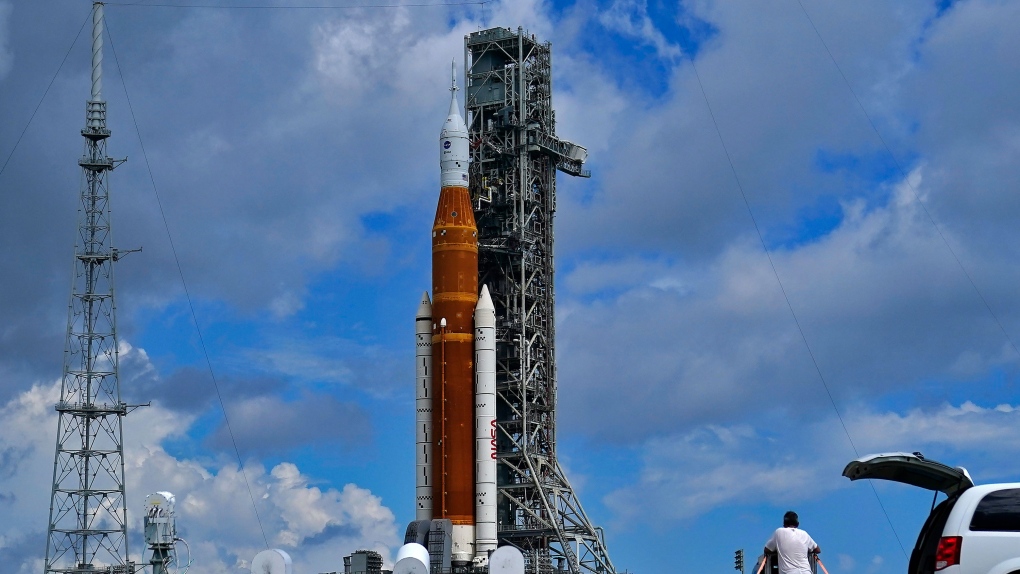
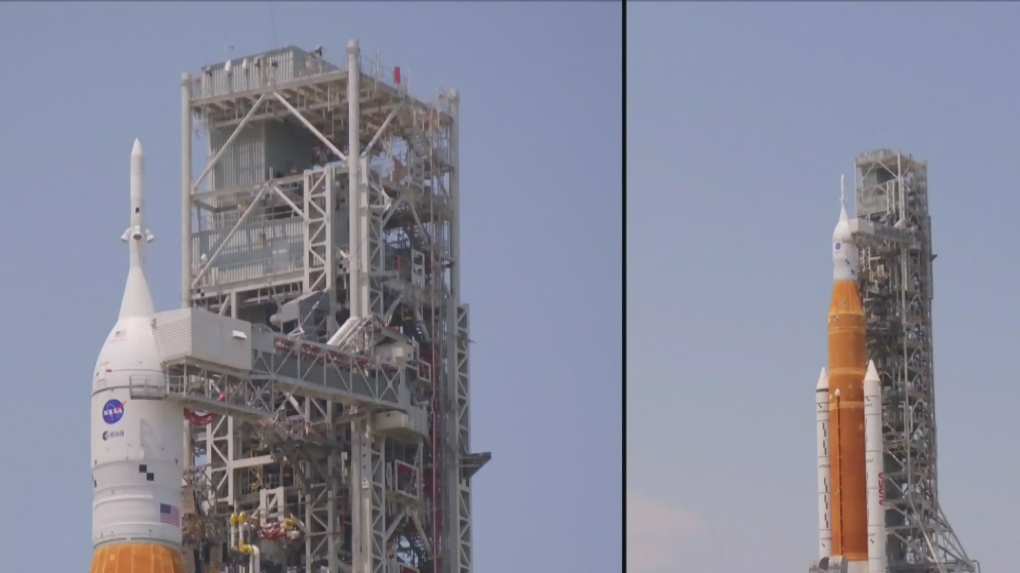
Marcia Dunn
The Associated Press
Updated Aug. 28, 2022
CAPE CANAVERAL, FLA. -
NASA's new moon rocket remained on track to blast off on a crucial test flight Monday, despite a series of lightning strikes at the launch pad.
The 322-foot (98-meter) Space Launch System rocket is the most powerful ever built by NASA. It's poised to send an empty crew capsule into lunar orbit, a half-century after NASA's Apollo program, which landed 12 astronauts on the moon.
Astronauts could return to the moon in a few years, if this six-week test flight goes well. NASA officials caution, however, that the risks are high and the flight could be cut short.
In lieu of astronauts, three test dummies are strapped into the Orion capsule to measure vibration, acceleration and radiation, one of the biggest hazards to humans in deep space. The capsule alone has more than 1,000 sensors.
Officials said Sunday that neither the rocket nor capsule suffered any damage during Saturday's thunderstorm; ground equipment also was unaffected. Five strikes were confirmed, hitting the 600-foot (183-meter) lightning-protection towers surrounding the rocket at NASA's Kennedy Space Center. The strikes weren't strong enough to warrant major retesting.
"Clearly, the system worked as designed," said Jeff Spaulding, NASA's senior test director.
More storms were expected. Although forecasters gave 80% odds of acceptable weather Monday morning, conditions were expected to deteriorate during the two-hour launch window.
On the technical side, Spaulding said the team did its best over the past several months to eliminate any lingering fuel leaks. A pair of countdown tests earlier this year prompted repairs to leaking valves and other faulty equipment; engineers won't know if all the fixes are good until just a few hours before the planned liftoff. If Monday doesn't pan out, the next launch attempt would be Friday.
After so many years of delays and setbacks, the launch team was thrilled to finally be so close to the inaugural flight of the Artemis moon-exploration program, named after Apollo's twin sister in Greek mythology.
"We're within 24 hours of launch right now, which is pretty amazing for where we've been on this journey," Spaulding told reporters.
The follow-on Artemis flight, as early as 2024, would see four astronauts flying around the moon. A landing could follow in 2025. NASA is targeting the moon's unexplored south pole, where permanently shadowed craters are believed to hold ice that could be used by future crews.------
The Associated Press Health and Science Department receives support from the Howard Hughes Medical Institute's Department of Science Education. The AP is solely responsible for all content.
RELATED IMAGES
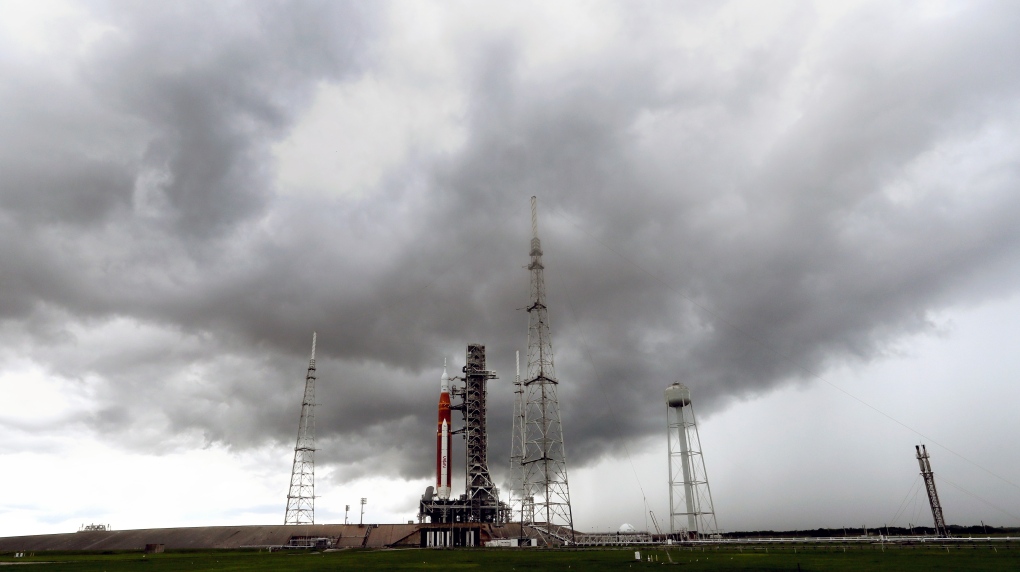
Storm clouds roll in over the NASA moon rocket as it stands ready for launch on Pad 39B for the Artemis 1 mission at the Kennedy Space Center on Aug. 27, 2022, in Cape Canaveral, Fla. The launch is scheduled for Monday morning, Aug. 29. (AP Photo/John Raoux)



The Associated Press
Updated Aug. 28, 2022
CAPE CANAVERAL, FLA. -
NASA's new moon rocket remained on track to blast off on a crucial test flight Monday, despite a series of lightning strikes at the launch pad.
The 322-foot (98-meter) Space Launch System rocket is the most powerful ever built by NASA. It's poised to send an empty crew capsule into lunar orbit, a half-century after NASA's Apollo program, which landed 12 astronauts on the moon.
Astronauts could return to the moon in a few years, if this six-week test flight goes well. NASA officials caution, however, that the risks are high and the flight could be cut short.
In lieu of astronauts, three test dummies are strapped into the Orion capsule to measure vibration, acceleration and radiation, one of the biggest hazards to humans in deep space. The capsule alone has more than 1,000 sensors.
Officials said Sunday that neither the rocket nor capsule suffered any damage during Saturday's thunderstorm; ground equipment also was unaffected. Five strikes were confirmed, hitting the 600-foot (183-meter) lightning-protection towers surrounding the rocket at NASA's Kennedy Space Center. The strikes weren't strong enough to warrant major retesting.
"Clearly, the system worked as designed," said Jeff Spaulding, NASA's senior test director.
More storms were expected. Although forecasters gave 80% odds of acceptable weather Monday morning, conditions were expected to deteriorate during the two-hour launch window.
On the technical side, Spaulding said the team did its best over the past several months to eliminate any lingering fuel leaks. A pair of countdown tests earlier this year prompted repairs to leaking valves and other faulty equipment; engineers won't know if all the fixes are good until just a few hours before the planned liftoff. If Monday doesn't pan out, the next launch attempt would be Friday.
After so many years of delays and setbacks, the launch team was thrilled to finally be so close to the inaugural flight of the Artemis moon-exploration program, named after Apollo's twin sister in Greek mythology.
"We're within 24 hours of launch right now, which is pretty amazing for where we've been on this journey," Spaulding told reporters.
The follow-on Artemis flight, as early as 2024, would see four astronauts flying around the moon. A landing could follow in 2025. NASA is targeting the moon's unexplored south pole, where permanently shadowed craters are believed to hold ice that could be used by future crews.------
The Associated Press Health and Science Department receives support from the Howard Hughes Medical Institute's Department of Science Education. The AP is solely responsible for all content.
RELATED IMAGES

Storm clouds roll in over the NASA moon rocket as it stands ready for launch on Pad 39B for the Artemis 1 mission at the Kennedy Space Center on Aug. 27, 2022, in Cape Canaveral, Fla. The launch is scheduled for Monday morning, Aug. 29. (AP Photo/John Raoux)
Lightning strikes Artemis I launchpad ahead of Monday launch
As NASA prepares for the first launch of its new Space Launch System rocket on Monday, lightning has been observed striking the launch pad at the Kennedy Space Center in Florida where the rocket is currently waiting. The lightning struck towers around the rocket which are designed to steer current away from sensitive hardware, and NASA says it is performing an assessment to check whether any systems have been damaged by the strikes.
Lightning and thunderstorms were seen in the area throughout the afternoon of Saturday, August 27. A video shared on Twitter by meteorologist Nick Stewart shows the lightning strike in slow motion, with what appears to be three consecutive strikes to the launch pad’s lightning towers:
Lightning striking around the pad was also captured in an image by photographer John Kraus:
NASA confirmed that there were three strikes on the lightning towers in total, one hitting Tower 1 and two hitting Tower 2. “Initial indications are that the strikes were of low magnitude,” NASA wrote. “A weather team has begun an assessment that includes collecting voltage and current data, as well as imagery. The data will be shared with a team of experts on electromagnetic environment efforts who will determine if any constraints on vehicle or ground systems were violated. Engineers will conduct a walkdown at the pad tonight, and if needed, conduct additional assessments with subsystems experts.”
The lightning towers are part of a lightning protection system in place at the launch pad for just such an occurrence. They are 600 feet tall and are designed to channel electricity down into the ground and away from any rocket, spacecraft, or supporting hardware that is on the pad.
A similar lightning strike happened in April this year when the Space Launch System rocket was on the pad at Kennedy for its wet dress rehearsal. Four lightning strikes hit the lightning towers, and one of these turned out to be the most powerful lightning strike ever recorded at the site. There was no damage to the rocket during this event as the lightning towers did their job.
Now, teams will continue their preparations for Monday’s launch including powering up the rocket’s core stage and charging the batteries for the Orion spacecraft.
As NASA prepares for the first launch of its new Space Launch System rocket on Monday, lightning has been observed striking the launch pad at the Kennedy Space Center in Florida where the rocket is currently waiting. The lightning struck towers around the rocket which are designed to steer current away from sensitive hardware, and NASA says it is performing an assessment to check whether any systems have been damaged by the strikes.
Lightning and thunderstorms were seen in the area throughout the afternoon of Saturday, August 27. A video shared on Twitter by meteorologist Nick Stewart shows the lightning strike in slow motion, with what appears to be three consecutive strikes to the launch pad’s lightning towers:
Lightning striking around the pad was also captured in an image by photographer John Kraus:
NASA confirmed that there were three strikes on the lightning towers in total, one hitting Tower 1 and two hitting Tower 2. “Initial indications are that the strikes were of low magnitude,” NASA wrote. “A weather team has begun an assessment that includes collecting voltage and current data, as well as imagery. The data will be shared with a team of experts on electromagnetic environment efforts who will determine if any constraints on vehicle or ground systems were violated. Engineers will conduct a walkdown at the pad tonight, and if needed, conduct additional assessments with subsystems experts.”
The lightning towers are part of a lightning protection system in place at the launch pad for just such an occurrence. They are 600 feet tall and are designed to channel electricity down into the ground and away from any rocket, spacecraft, or supporting hardware that is on the pad.
A similar lightning strike happened in April this year when the Space Launch System rocket was on the pad at Kennedy for its wet dress rehearsal. Four lightning strikes hit the lightning towers, and one of these turned out to be the most powerful lightning strike ever recorded at the site. There was no damage to the rocket during this event as the lightning towers did their job.
Now, teams will continue their preparations for Monday’s launch including powering up the rocket’s core stage and charging the batteries for the Orion spacecraft.
NASA's massive moon rocket poised to launch Monday morning
'It's no longer the Apollo generation. It's the Artemis
generation,' says NASA administrator

The countdown is on.
NASA's massive rocket, called the Space Launch System (SLS), is ready to blast off Monday morning from Cape Canaveral, Fla.
Atop the rocket sits Orion, the spacecraft that will eventually take astronauts to the moon.
This mission — dubbed Artemis I — is a critical test of several things: how SLS performs; how Orion performs; and how its heat shield holds up upon re-entry after travelling to the moon and coming in at extremely high speeds.
There are also several tests on board, including radiation experiments on three mannequins. High doses of space radiation can be lethal to humans.
All of this is to pave way for Artemis II — scheduled for 2024 or 2025 — when four astronauts, including a Canadian, will orbit the moon.

The rocket is set to launch no earlier than 8:33 a.m. ET Monday morning, with a two-hour launch window.
During a mission briefing on Saturday, Jacob Bleacher, chief exploration scientist for NASA's Human Exploration and Operations Mission Directorate, said, "Buckle up everybody. We are going to the moon."
Mike Sarafin, mission manager for Artemis, said the feeling around the Kennedy Space Center has become increasingly energetic.
"As our zero hour approaches for the Artemis generation, we do have a heightened sense of anticipation, and there is definitely excitement among the team members," he said. "We've noticed just the overall mood and focus within the team is definitely a positive one."
This is a mission more than a decade in the making. Former U.S. president Barack Obama made the announcement of the SLS rocket in 2010, with a goal of flying in 2016. The dates for SLS — as well as cost overruns — plagued the giant rocket for years.
However, this isn't the first ride for the Orion capsule. It was launched on an Delta IV Heavy rocket in December 2014 in an orbit around Earth, splashing down just over four hours later.

But this will be an entirely different trip for the capsule. When Orion returned for its test, called EFT-1, it re-entered the atmosphere at roughly 32,000 km/h. This time, after its 42-day mission, the capsule will be pushed to its limits coming in at a blistering speed of 40,000 km/h, reaching temperatures of up to 2,800 C.
Long-term exploration
Everyone on the team is cognizant that Artemis I is a test: that things could go wrong, but that they will learn from it.
"We're mindful that this is a test flight. And we're mindful that this is a purposeful stress test of the Orion spacecraft and the Space Launch System rocket. It is a new creation. It is a new rocket and it is a new spacecraft to send humans to the moon on the very next flight," Sarafin said.
"This is something that has not been done in over 50 years and it is incredibly difficult."
After Artemis II is Artemis III, which will put boots on the ground and, as NASA is keen to stress, put the first woman and the first person of colour on the lunar surface.
The Artemis program is a long-term goal to send humans back to the moon and beyond. NASA has Mars firmly in its sights. But they're not planning on doing it alone.
Unlike the Apollo missions, this is an international effort. The European Space Agency has provided a service module for the Artemis program, and Canada is providing Canadarm 3 to the Lunar Gateway, a space station that will orbit the moon and serve as an outpost, a kind of jumping-off point for astronauts travelling to the moon or Mars.
"There's a big, big universe to explore. And this is just the next step in that exploration. And this time we go with our international partners," Bill Nelson, a NASA administrator, said in a briefing on Saturday.
"It's no longer the Apollo generation. It's the Artemis generation."
NASA says the goal for the Artemis program is to one day land on Mars. But first, the space agency needs Artemis missions to once again land on the moon.
To the Moon and beyond: NASA's Artemis program
2022/08/27

Cape Canaveral (AFP) - The Artemis program is NASA's plan to return humans to the Moon as a stepping stone for an eventual voyage to Mars.
Twelve men walked on the Moon between 1969 and 1972 and one of the goals of Artemis is to put the first woman and person of color on the lunar surface.
The first test flight of an uncrewed Artemis rocket is to take place on Monday.
The name Artemis was chosen to echo that of the Apollo program.
Artemis, in Greek mythology, was the twin sister of Apollo and a goddess associated with the Moon.
Here is an overview of the Artemis program:
Artemis 1: test flight
Artemis 1 is a test flight of the 322-foot (98-meter) Space Launch System rocket and the Orion crew capsule that sits on top.
Blastoff is scheduled for 8:33 am (1233 GMT) on Monday from the Kennedy Space Center in Florida.
Mannequins equipped with sensors will take the place of crew members on the flight, recording vibration, acceleration and radiation levels.
Orion will orbit the Moon before splashing down in the Pacific Ocean.
Artemis 2: first crew
Planned for 2024, Artemis 2 will be a crewed flight that will orbit the Moon but not land on the surface, similar to what Apollo 8 did.
The four members of the crew will be named before the end of the year. A Canadian is expected to be among them.
Artemis 3: Moon landing
The third Artemis mission will be the first to put astronauts on the Moon since Apollo 17 in December 1972.
NASA, for the first time, will land a crewed spacecraft on the southern pole of the Moon, where water in the form of ice has been detected.
Previous Moon landings took place near the equator.
Artemis 3 is scheduled for 2025 but may not take place until 2026 at the earliest, according to an independent audit of the program.
Starting with Artemis 3, NASA plans to launch crewed missions about once a year.
SpaceX Moon lander
NASA has selected Elon Musk's SpaceX to build the Moon lander for Artemis 3.
SpaceX's Starship, which is still under development, will serve as a shuttle from the Orion crew capsule to the lunar surface and back.
Gateway space station
The Artemis program also calls for the construction of a space station called Gateway that will orbit the Moon.
The launch of the first two elements -- the living quarters module and power and propulsion system -- is planned for late 2024 at the earliest by a SpaceX Falcon Heavy rocket.
Orion crews would be responsible for assembly of Gateway.
Astronauts would spend between 30 to 60 days in Gateway and would eventually have access to a lander that would allow them to travel to the Moon and back.
Gateway would also serve as a stopping point for any future trip to Mars.
Destination Mars
The ultimate objective of the Artemis program is what NASA calls the "next giant leap -- human exploration of Mars."
NASA will use knowledge gained from Artemis about next generation spacesuits, vehicles, propulsion, resupply and other areas to prepare for a trip to Mars.
The goal is to learn how to maintain a human presence in deep space for a long period.
Creating a "base camp" on the Moon is part of the plan with astronauts staying on the lunar surface for up to two months.
While a trip to the Moon takes just a few days, a voyage to Mars would take a minimum of several months.
© Agence France-Presse
Eoghan Moloney
August 28 2022
Nasa’s most powerful rocket in history - the Space Launch System (SLS) - will blast off from Kennedy Space Centre in Cape Canaveral on Monday afternoon.
This marks a new era in Space exploration for Nasa. The first launch of the new SLS rocket, which is entitled Artemis 1, is the beginning of the US space agency’s aim to put astronauts back on the moon within three years.
What is so special about the new rocket?
It is the most powerful rocket ever made, for starters. It will generate 3.9 million kilos of thrust, enough to keep around 22 jumbo jets in flight.
The rocket will reach close to 6,400 kilometres per hour in just two minutes. Within eight minutes, it will be travelling at close to 29,000km/h. Fast enough to circle the entire planet in approximately 80 minutes. Top speed will be around 36,000km/h. To put this into perspective - it’s the equivalent of travelling from Dublin to New York in roughly eight minutes.
The Space Launch System (SLS) rocket will create the most force ever generated by a rocket when it lifts off on Monday. During testing of the SLS in Utah, the engines generated so much heat it fused desert sand into glass.
Read MoreNASA astronaut snaps incredible photo of Dublin at night from the skies
The lift-off will be broadcast live on Nasa’s website and YouTube channel and it is scheduled to take off at approximately 13:33pm Irish time.
What’s so special about this mission?
Tomorrow’s blast-off is the first real test of the SLS rocket. Nasa thinks it can carry the unmanned Orion spacecraft around the moon and back, but tomorrow they will find out for sure.
This has a lot of folks nervous at Nasa.
Nasa Administrator Bill Nelson told CBS News on Sunday: "I'm afraid that people think it's routine. But when those candles light off, it's anything but routine. It is a high-wire act all the way up. ... This is a big deal. And it is beautiful. And it is a monster. The size just overwhelms you”.
And if it’s successful?
If it does what Nasa believes it will, the SLS rocket will lead to humans travelling further than ever before from earth and will also see more astronauts and equipment sent to the moon at quicker speeds for exploration.
Artemis III in 2024 will aim to be the first mission to put a woman and a person of colour on the moon, Nasa said.
“The next step is to start sending people on bold missions to the Moon and beyond. As SLS evolves over future missions to unprecedented accommodation of payload mass and volume and unrivalled performance, the rocket will allow Nasa to send missions to deep space and reach distant destinations faster than ever before.
“On its second mission carrying Orion and astronauts, Artemis II, SLS will send Orion and its crew farther than people have travelled before, around 250,000 miles from Earth, 10,000 miles beyond the Moon.
“On the third flight, Artemis III, SLS will send Orion and astronauts on a mission in 2024 that will land on the Moon. Americans along with their international and commercial partners will use the Moon as a proving ground to test technologies and prepare for missions to Mars,” Nasa said of the mission.
Could things go wrong?
You bet. Nasa are quite worried ahead of Monday’s launch, which is anticipated to attract up to 200,000 in-person spectators to Florida.
"This is a very risky mission," Jim Free, Nasa's associate director for exploration systems development told reporters on Saturday in Florida.
"We do have a lot of things that could go wrong during the mission in places where we may come home early, or we may have to abort to come home.
"Our potential outcomes on Monday are that we can go within the window, or we could scrub for any number of reasons. We're not going to promise that we're going to get off on Monday,” Mr Free said.
Currently, forecasts are showing an 80pc chance of good weather around launch time. There’s a two-hour window in which Artemis I can launch or the plug has to be pulled.
How long will the mission last?
Six weeks. It’s anticipated the Orion spacecraft will re-enter Earth’s atmosphere on October 10 after getting within 60 miles of the moon on day six and then orbiting it for a number of weeks, before, hopefully, splashing down into the Pacific Ocean.

No comments:
Post a Comment